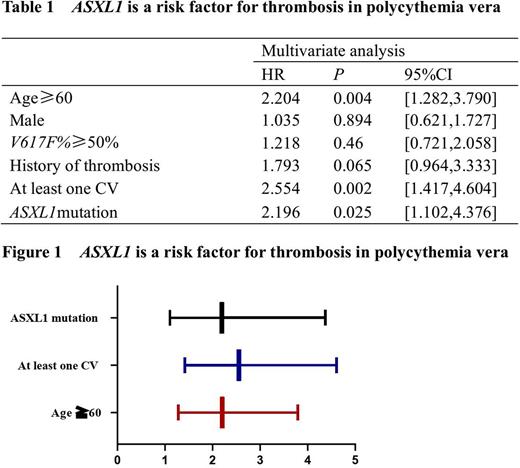Abstract
Objective To explore the risk factors of thrombosis in PV patients and establish the prognostic model of thrombosis in PV patients.
Methods The clinical data of 1004 PV patients who were treated in the Second Hospital of Tianjin Medical University from September 2017 to May 2022 were retrospectively analyzed. Kaplan-Meier survival analysis and Cox multivariate analysis were used to analyze the risk factors of thrombosis in PV patients and the thrombosis prognosis model.
Results Among the 1004 PV patients, 473 patients (47.1%) developed thrombosis, and 54.8% of the patients developed thrombosis after PV was diagnosed. Thrombosis occurred in 68.4% of patients with ASXL1-mutant PV. Cox multivariate analysis showed that: age≥60 years (P=0.004, HR=1.608, 95%CI[1.168,2.213]), JAK2V617F allele burden (V617F%)≥50% (P=0.04, HR=1.396, 95%)CI[1.015, 1.920]), history of thrombosis (P<0.0001, HR=2.115, 95%CI[1.501,2.980]), at least one cardiovascular risk factor (P<0.0001, HR=1.851, 95%CI[1.310],2.615]) is a risk factor for thrombosis in PV patients. According to the results of Cox multivariate analysis, each risk factor was assigned 1 point, and a prognostic model of PV thrombosis was established. The incidence of thrombosis in the low-risk group (0 points), intermediate-risk group (1 point) and high-risk group (≥2 points) were 70.3%, 34.9%, and 19.7%, respectively.
Conclusion Patients with ASXL1-mutated PV are at increased risk of thrombosis. The prognostic model of thrombosis in PV patients established by age≥60 years, V617F% ≥50%, history of thrombosis, and at least one cardiovascular risk factor can effectively predict thrombosis in PV patients.
Disclosures
No relevant conflicts of interest to declare.
Author notes
Asterisk with author names denotes non-ASH members.


This feature is available to Subscribers Only
Sign In or Create an Account Close Modal